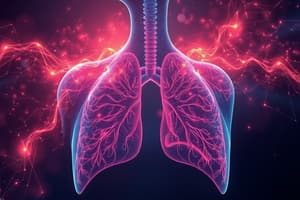Podcast
Questions and Answers
According to Boyle's law, what happens to the pressure within the lungs as the volume increases during inspiration?
According to Boyle's law, what happens to the pressure within the lungs as the volume increases during inspiration?
- The pressure increases to facilitate inspiration.
- The pressure remains constant.
- The pressure decreases to facilitate inspiration. (correct)
- The pressure first increases and then decreases.
What is the typical range of the intrathoracic (intrapleural) pressure during the respiratory cycle?
What is the typical range of the intrathoracic (intrapleural) pressure during the respiratory cycle?
- -10 to -12.5 cmH2O
- -5 to -7.5 cmH2O (correct)
- -2.5 to -5 cmH2O
- -7.5 to -10 cmH2O
What is the relationship between alveolar pressure and pleural pressure during respiration?
What is the relationship between alveolar pressure and pleural pressure during respiration?
- Alveolar pressure is always greater than pleural pressure.
- Alveolar pressure is greater than pleural pressure during inspiration and less during expiration. (correct)
- Alveolar pressure is equal to pleural pressure.
- Alveolar pressure is always less than pleural pressure.
What is the primary purpose of the negative intrathoracic (intrapleural) pressure?
What is the primary purpose of the negative intrathoracic (intrapleural) pressure?
Which of the following correctly describes the relationship between respiratory rate and normal breathing?
Which of the following correctly describes the relationship between respiratory rate and normal breathing?
Which of the following processes is involved in the exchange of gases between the body and the atmosphere during respiration?
Which of the following processes is involved in the exchange of gases between the body and the atmosphere during respiration?
What is the approximate percentage of total body energy utilized during the respiratory process?
What is the approximate percentage of total body energy utilized during the respiratory process?
Which of the following muscles is NOT involved in forced inspiration?
Which of the following muscles is NOT involved in forced inspiration?
What is the normal value for total compliance of the lungs and chest wall?
What is the normal value for total compliance of the lungs and chest wall?
Which of the following is NOT a characteristic of compliance?
Which of the following is NOT a characteristic of compliance?
What is the typical cause of diaphragm paralysis?
What is the typical cause of diaphragm paralysis?
What is the relationship between the compliance of the lungs and the chest wall?
What is the relationship between the compliance of the lungs and the chest wall?




